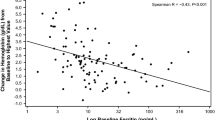Abstract
The intravenous formulation for supplementing iron currently available in Japan requires frequent administration. In contrast, ferric carboxymaltose (FCM) can improve iron-deficiency anemia (IDA) with only a small number of administrations; however, its efficacy and safety have not been established in Japanese patients. In this randomized, open-label study, we verified the noninferiority of FCM to saccharated ferric oxide (SFO) in Japanese patients with IDA due to hypermenorrhea, with the mean change from baseline to the highest observed hemoglobin level as the primary endpoint. Two hundred and thirty-eight eligible subjects (119 in FCM group, 119 in SFO group) were administered the investigational medicinal product and included in the analysis. The adjusted mean change from baseline to the highest observed hemoglobin level (95% CI) was 3.90 g/dL (3.77, 4.04) in the FCM group and 4.05 g/dL (3.92, 4.19) in the SFO group, and the difference between the groups (95% CI) was − 0.15 g/dL (− 0.35, 0.04). The noninferiority of FCM was verified. Incidence of adverse events was < 60% in both groups, and no significant difference was observed between the treatment groups. These results indicate that FCM can be a new, well-tolerated, and rapid treatment option for Japanese patients with IDA.




Similar content being viewed by others
References
World Health Organization. Iron deficiency anemia—assessment, prevention, and control. A guide for program managers. Report No.: Document WHO/NHD/01.3. 2001.
Harigae H. Iron metabolism and related diseases. Int J Hematol. 2018;107:5–6.
Adamson JW. Iron deficiency and other hypoproliferative anemias. In: Longo DL, Fauci AS, Kasper DL, Hauser SL, Jameson JL, Loscalzo J, editors. Harrison’s principles of internal medicine. 18th ed. New York: McGraw-Hill Companies; 2013. pp. 844–51.
Marret H, Fauconnier A, Chabbert-Buffet N, Cravello L, Golfier F, Gondry J, et al. Clinical practice guidelines on menorrhagia: management of abnormal uterine bleeding before menopause. Eur J Obstet Gynecol Reprod Biol. 2010;152:133–7.
Funk F, Ryle P, Canclini C, Neiser S, Geisser P. The new generation of intravenous iron: chemistry, pharmacology, and toxicology of ferric carboxymaltose. Arzneimittelforschung. 2010;60:345–53.
Beshara S, Sörensen J, Lubberink M, Tolmachev V, Långström B, Antoni G, et al. Pharmacokinetics and red cell utilization of 52Fe/59Fe-labelled iron polymaltose in anaemic patients using positron emission tomography. Br J Haematol. 2003;120:853–9.
Girelli D, Ugolini S, Busti F, Marchi G, Castagna A. Modern iron replacement therapy: clinical and pathophysiological insights. Int J Hematol. 2018;107:16–30.
Cada DJ, Levien TL, Baker DE. Ferric carboxymaltose. Hosp Pharm. 2014;49:52–69.
Ikuta K, Shimura A, Terauchi M, Yoshii K, Kawabata Y. Pharmacokinetics, pharmacodynamics, safety, and tolerability of intravenous ferric carboxymaltose: a dose-escalation study in Japanese volunteers with iron-deficiency anemia. Int J Hematol. 2018;107:519–27.
Van Wyck DB, Mangione A, Morrison J, Hadley PE, Jehle JA, Goodnough LT. Large-dose intravenous ferric carboxymaltose injection for iron deficiency anemia in heavy uterine bleeding: a randomized, controlled trial. Transfusion. 2009;49:2719–28.
Seid MH, Butcher AD, Chatwani A. Ferric carboxymaltose as treatment in women with iron-deficiency anemia. Anemia. 2017;2017:9642027.
Suzuki T, Tomonaga M, Miyazaki Y, Nakao S, Ohyashiki K, Matsumura I, et al. Japanese epidemiological survey with consensus statement on Japanese guidelines for treatment of iron overload in bone marrow failure syndromes. Int J Hematol. 2008;88:30–5.
Shenoy N, Vallumsetla N, Rachmilewitz E, Verma A, Ginzburg Y. Impact of iron overload and potential benefit from iron chelation in low-risk myelodysplastic syndrome. Blood. 2014;124:873–81.
Yamamoto H, Nishi S, Tomo T, Masakane I, Saito K, Nangaku M, et al. 2015 Japanese Society for Dialysis Therapy: guidelines for renal anemia in chronic kidney disease. Renal Replace Ther. 2017;3:36.
Acknowledgements
The authors are grateful to the patients and their families for their contributions. Funding was provided by Zeria Pharmaceutical Co., Ltd.
Author information
Authors and Affiliations
Corresponding author
Ethics declarations
Conflict of interest
The present study was performed as a Phase III study funded by Zeria Pharmaceutical Co., Ltd. Hanashi, Hirai and Ota received research funding from Zeria Pharmaceutical Co., Ltd. Ikuta received personal fees as medical specialist from Zeria Pharmaceutical Co., Ltd. Momoeda received personal fees as coordinating investigator from Zeria Pharmaceutical Co., Ltd. Matsuyama received personal fees as medical statistics advisor from Statcom Company Limited. Shimura and Terauchi are employees of Zeria Pharmaceutical Co., Ltd.
Electronic supplementary material
Below is the link to the electronic supplementary material.

Supplemental Fig. 1
Proportion of subjects achieving increase in hemoglobin ≥2 g/dL based on the change in hemoglobin (Proportion±95% CI) (FAS). Proportion of subjects achieving a hemoglobin increase ≥2.0 g/dL at each evaluation point. Filled circle: ferric carboxymaltose, open circle: saccharated ferric oxide (JPEG 69 KB)

Supplemental Fig. 2
Proportion of subjects with a normalized hemoglobin (Proportion±95% CI) (FAS). Proportion of subjects achieving a hemoglobin≧12.0 g/dL at each evaluation point. Filled circle: ferric carboxymaltose, open circle: saccharated ferric oxide (JPEG 69 KB)
About this article
Cite this article
Ikuta, K., Hanashi, H., Hirai, K. et al. Comparison of efficacy and safety between intravenous ferric carboxymaltose and saccharated ferric oxide in Japanese patients with iron-deficiency anemia due to hypermenorrhea: a multi-center, randomized, open-label noninferiority study. Int J Hematol 109, 41–49 (2019). https://doi.org/10.1007/s12185-018-2501-8
Received:
Revised:
Accepted:
Published:
Issue Date:
DOI: https://doi.org/10.1007/s12185-018-2501-8




